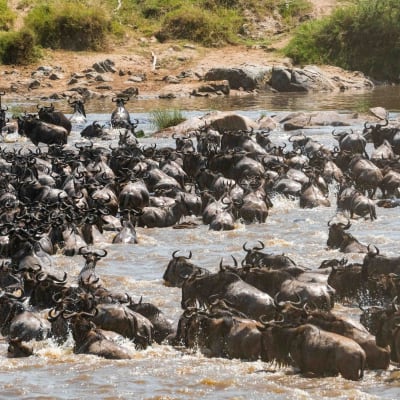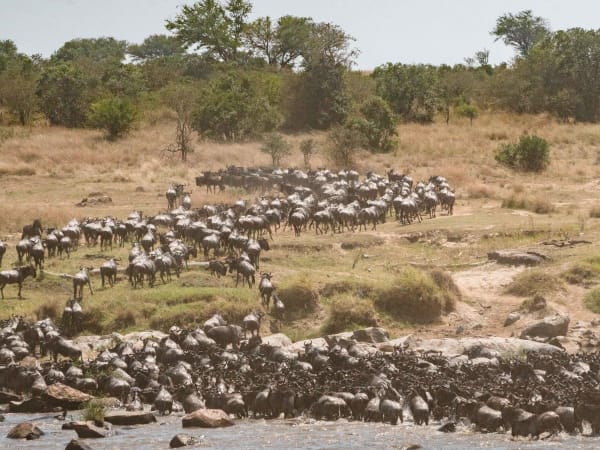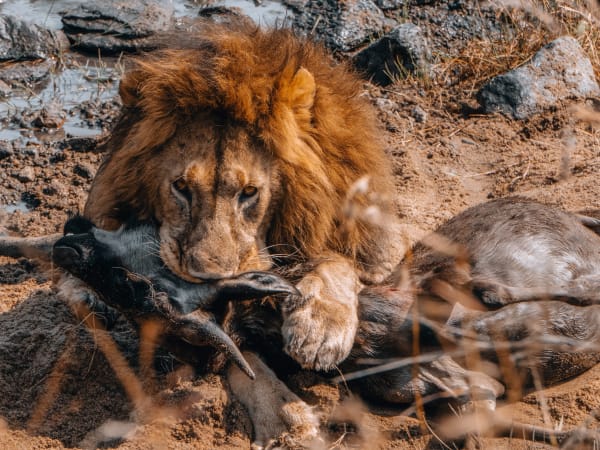
The Great Migration
The ultimate safari experience in Kenya and Tanzania
The ultimate safari experience in Kenya and Tanzania
Let yourself be enchanted by the magic of the Great Migration and immerse yourself in the African adventure. In the following sections, you will find out when and where you can best observe this extraordinary event, receive valuable tips on planning your luxury safari and discover the best accommodation along the migration route. Prepare to quench your wanderlust and plan an unforgettable travel experience.
What is the Great Migration?
Imagine standing in the middle of the vast, golden savannahs of Africa, surrounded by millions of migrating animals. The Great Migration of wildebeest, zebra and gazelle is a truly awe-inspiring natural spectacle that crosses the Serengeti in Tanzania and the Masai Mara in Kenya every year. This epic journey, during which the herds cover over 800 kilometers, follows the ancient rhythm of the rainy seasons and the growth of fresh grasses.
Every year, around 1.2 million wildebeest, accompanied by 300,000 zebras and countless gazelles, migrate across the endless plains in search of food and water. But this journey is not without its dangers: Predators such as lions, leopards and crocodiles lie in wait for the weaker members of the herd, and the treacherous river crossings take their toll. These challenges and the sheer number of animals involved make the migration one of the most spectacular and dramatic natural spectacles in the world.
But the Great Migration is more than just a visual spectacle. It is a powerful example of the survival strategies of African wildlife and a demonstration of the impressive adaptability of these animals. Scientists believe that the herds determine their direction by reacting to distant lightning and thunder, always on the lookout for the best grazing grounds.
Which animals can be observed during a Great Migration safari?
During a Great Migration safari, you will experience an impressive variety of wildlife. The main players are the approximately 1.2 million wildebeest, accompanied by around 300,000 zebras and countless Thomson's and Grant's gazelles. These huge herds attract predators such as lions, leopards, cheetahs, hyenas and crocodiles, which are always on the hunt for prey.
In addition to these dramatic scenes, you can also spot elephants, buffalo, giraffes and a variety of bird species that populate the Serengeti and Masai Mara. In the southern Serengeti, during the calving season in January and February, you have the opportunity to witness the birth of thousands of wildebeest calves, which in turn attracts numerous predators hoping for easy prey.
Where does the Great Migration take place?
The Great Migration takes place across the vast, breathtaking landscapes of the Serengeti in Tanzania and the Masai Mara in Kenya. These two regions form the heart of this incredible spectacle.
Tanzania: Serengeti National Park
The journey begins and ends in the Serengeti, one of Africa's most famous national parks. The Serengeti stretches over some 30,000 square kilometers and offers diverse wildlife and spectacular landscapes. Here the herds cross the southern, central, western and northern plains, with each region offering unique viewing opportunities.
Kenya: Masai Mara
From July, the herds reach the Masai Mara in Kenya, where they stay until around October. This region is known for its dense animal population and the spectacular scenes that take place during the river crossings of the Mara River.
Migration process and seasons
December to March: time for new life
The migration begins in the southern Serengeti, where the herds stay from December to March. During this time, over 400,000 wildebeest calves are born, attracting numerous predators. This phase offers dramatic scenes of birth and hunting.
April to June: Migration to the north
After the calving season, the herds slowly move north into the central and western Serengeti. In May, the mating season begins and the animals gather in large groups. In June, they reach the Grumeti and Mbalageti rivers, where they attempt their first dangerous river crossings.
July to October: River crossings
The most exciting phase of the migration takes place from July to October, when the herds cross the Mara and Talek Rivers in the northern Serengeti and the Masai Mara. These dramatic crossings, during which the animals fight against strong currents and lurking crocodiles, are an absolute highlight.
November: Return to the south
In November, after the short rains, the herds return from the Masai Mara to the Serengeti. They move south to take advantage of the fresh pastures and prepare for the next calving season.

The Serengeti and Masai Mara offer incredible wildlife experiences all year round, but the Great Migration is undoubtedly the highlight. Each region has its own special features and each phase of the migration brings unique and unforgettable moments.
The Great Migration: month by month
If you are planning your trip to East Africa and would like to see the wildebeest herds, it is important to know when the animals are where. Here we give you a detailed insight into each month of the year so that you can prepare for your trip in theory. Nevertheless, it is never possible to predict exactly when the animals will be where, as they are guided by the rains and these can also shift from year to year.
January
- Location: Ndutu Area
- Highlight: Start of calving season, thousands of wildebeest calves are born, numerous predators are active.
February
- Location: Ndutu Area, southern Serengeti
- Highlight: Peak of the calving season, around 8,000 calves are born every day, ideal time for observing predators.
March
- Location: Southern Serengeti, Maswa Game Reserve
- Highlight: The herds are preparing to migrate north, predators are still present.
April
- Location: Southern Serengeti, Central Serengeti
- Highlight: The northward migration begins, the herds slowly move towards the central Serengeti.
May
- Location: Central Serengeti, Moru Kopjes
- Highlight: Mating season, impressive fights between male wildebeest, the herds gather in large groups.
June
- Location: Western Corridor, Grumeti River
- Highlight: First river crossings, the herds gather along the Grumeti River.
July
- Location: Northern Serengeti
- Highlight: Major river crossings of the Mara River begin, excitement builds.
August
- Location: Northern Serengeti, Masai Mara
- Highlight: Dramatic river crossings, predators lurk near the rivers.
September
- Location: Masai Mara
- Highlight: The herds are spread out in the Masai Mara, daily river crossings on the Mara River.
October
- Location: Masai Mara, Northern Serengeti
- Highlight: The herds begin their return south, last river crossings.
November
- Location: Eastern Serengeti
- Highlight: The herds return to the Serengeti, the rainy season begins and fresh grass sprouts.
December
- Location: Central Serengeti, Ndutu
- Highlight: The herds arrive in the south, the calving season begins again.
Comparison: Kenya vs. Tanzania
Kenya:
The Masai Mara National Reserve in Kenya is world-famous for the dramatic river crossings of the Mara River, which take place from July to October. This region is easily accessible and offers an excellent tourist infrastructure with luxurious camps and lodges. Families and first-time visitors will find a wealth of activities here, from hot air ballooning to cultural encounters and exclusive safaris in private concessions.
- River crossings: The famous Mara River crossings are a highlight of the migration.
- Access and infrastructure: Kenya is known for its excellent tourism infrastructure and easy accessibility to the Masai Mara. This region is ideal for families and offers a variety of accommodation options that offer both luxury and comfort.
- Activities: Apart from game viewing, Kenya offers unique experiences such as hot air balloon rides over the savannah, cultural encounters with the Maasai and exclusive safari activities in private concessions.
Tanzania:
In the Serengeti in Tanzania, you can catch a glimpse of the Great Migration almost all year round. The wildebeest herds move through various regions of the Serengeti, from the southern plains to the dramatic river crossings of the Grumeti River in the west and the Mara River in the north. This gives you the opportunity to observe the migration at less crowded times, such as during the months of January to May.
- Calving season: From December to March in the southern Serengeti.
- River crossings: In June and July in the western corridor and from July to October in the north.
- Experience: The migration crosses different regions of the Serengeti, from the southern plains during the calving season to the dramatic river crossings of the Grumeti River in the west and the Mara River in the north. Each region has its own unique fascination.
Tips for planning your safari
A Great Migration safari is an unforgettable experience that requires careful planning to make the most of it. Here are some valuable tips to help you optimize your trip:
Book early
The Great Migration attracts many visitors every year. To avoid having to make too many compromises and to get the accommodation you want, you should book your trip at least a year in advance. Especially during the summer months, when the wildebeest herds are in the north of the Serengeti, it gets very crowded and booking early guarantees you a wider choice and better prices.
Budget planning
A Great Migration safari can be costly, but with careful budgeting you can get the most out of your trip. Consider not only the cost of accommodation and transportation, but also additional activities, national park fees and tips. A well-thought-out budget will help you avoid unexpected expenses and enjoy your trip stress-free.
Prices vary depending on the season. In the high season, when the river crossings take place, the costs are higher. A trip in the low season can be cheaper and still offer great viewing opportunities.
Choosing accommodation
Choosing the right accommodation is crucial to your safari experience. Opt for camps and lodges that are strategically located along the migration route. A mobile migration camp offers optimal conditions for game viewing as it is positioned in a prime location. These tented camps offer an authentic and rustic experience where you don't have to compromise on anything. If you want something a little more luxurious and comfortable, the permanent lodges also offer great opportunities to see the herds of animals.
Length of stay
To experience the migration in all its splendor, you should allow enough time. A stay of at least four nights is recommended, as there can always be weather-related changes or unpredictable animal movements.
Private vehicle
A private vehicle gives you the freedom and flexibility to experience the Great Migration at your own pace. You can stop spontaneously to capture special moments and have more control over your itinerary. A private vehicle also allows you to drive off the beaten track and explore less crowded areas.
Advice from experts
A Great Migration safari is a complex undertaking, and advice from experienced travel experts can make all the difference. Experts know the best times to travel, routes and accommodation and can give you tailored recommendations. Use their knowledge and experience to plan an unforgettable trip.
If you are now interested in traveling to the Great Migration in Kenya or Tanzania. Contact us at any time, we will be happy to help and advise you!
Experience the magic of Africa with experts who have explored every corner themselves
Your dream holiday, tailor-made by experts.
Our travel consultants not only admire Africa from afar, but explore the most impressive regions every year to experience the cultures, landscapes and safari experiences first-hand.
From the initial inspiration to the moment you return home full of stories, we will accompany you personally - be it by phone, email or WhatsApp, whenever you need us. Explore the wilderness of Africa, be enchanted by its breathtaking beauty and create unforgettable memories. Together we will create your unique safari adventure!
Experts for your Africa trip


















